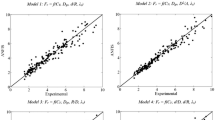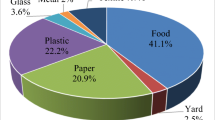Abstract
The tunnel desilter is a simple and economical fluidic device which is the most suitable over other alternative devices for the region if water is abundantly available. The flow mechanism in the tunnel desilter is so complex that it is difficult to estimate the sediment removal efficiency accurately using a conventional regression. Hence, in the present study AI-based techniques, adaptive neurofuzzy interface system (ANFIS) and artificial neural network (ANN), were employed to estimate the sediment removal efficiency of the tunnel desilter using the data-sets collected by conducting the laboratory test. Findings of the sensitivity analysis showed that the size of the sediment was the most significant parameter followed by the concentration in the estimation of removal efficiency. The results of AI-based modeling were also compared with the available conventional predictive regression models, and it was found that the triangular membership function-based ANFIS model outperformed the other considered models. Further, ANN was also found to be giving comparable results.


















Similar content being viewed by others
Abbreviations
- a :
-
Nondimensional bed layer thickness (2S) relative to depth of flow (D)
- C :
-
Sediment concentration (ppm)
- D :
-
Flow depth (m)
- d u :
-
Diameter of under flow outlet which is equal to the width of subtunnel (m)
- k :
-
Von Karman’s constant = 0.4
- n :
-
Number of observations
- Q i :
-
Discharge in inlet channel, i.e., discharge in subtunnel (m3/s)
- R :
-
Extraction ratio (%)
- S :
-
Sediment size (mm)
- \(U_{*}\) :
-
Shear velocity (m/s)
- \(U_{*}^{{\prime }}\) :
-
Grain shear velocity (m/s)
- V :
-
Mean velocity of flow (m/s)
- x i :
-
Observed values
- \(\bar{x}\) :
-
Mean observed values
- y i :
-
Predicted values
- \(\bar{y}\) :
-
Mean predicted values
- z :
-
Any depth of water from the bed level (m)
- α:
-
Ratio of height of diaphragm slab to depth of water in case of tunnel-type silt ejector
- \(\eta\) :
-
Sediment removal efficiency
- \(\omega\) :
-
Fall velocity of the sediment particle (m/s)
- \(\gamma_{\text{f}}\) :
-
Weight density of fluid (KN/m3)
- \(\gamma_{\text{s}}\) :
-
Weight density of sediment (KN/m3)
- W :
-
Vertical upward velocity (m/s)
- W′:
-
Width of channel
References
Ansari MA, Athar M (2013) Artificial neural networks approach for estimation of sediment removal efficiency of vortex settling basins. ISH J Hydraul Eng 19(1):38–48
Athar M, Kothyari UC, Garde RJ (2002) Sediment removal efficiency of vortex chamber type sediment extractor. J Hydraul Eng 128(12):1051–1059
Athar M, Kothyari UC, Garde RJ (2003) Distribution of sediment concentration in the vortex chamber type sediment extractor. J Hydraul Res 41(4):427–438
Atkinson E (1994a) Vortex-tube sediment extractors. I: trapping efficiency. J Hydraul Eng 120(10):1110–1125
Atkinson E (1994b) Vortex-tube sediment extractors. II: design. J Hydraul Eng 120(10):1126–1138
Atkinson E, Lawrence P (1984) A quantitative design method for tunnel type sediment extractors. In: Fourth congress, Asian and Pacific Division, Indian Association for Hydraulic Research, Chiang Mai-Thailand, pp 77–81
Bishop CM (1995) Neural networks for pattern recognition. Oxford University Press, Oxford
Blench T (1952) Discussion of model and prototype studies of sand traps, by RL Parshall. Trans ASCE 117:213
Cui ZD, Tang YQ, Yan XX, Yan CL, Wang HM, Wang JX (2010) Evaluation of the geology-environmental capacity of buildings based on the ANFIS model of the floor area ratio. Bull Eng Geol Environ 69(1):111–118
Curi KV, Esen II, Velioglu SG (1979) Vortex type solid liquid separator. Progr Water Technol 7(2):183–190
Dashtbozorgi S, Asareh A (2015) Study of the rate of sediment trapping and water loss in the vortex tube structure at different placement angles. J Sci Res Dev 2(5):104–110
Dhillon GS, Aggarwal RK, Kotwal AN (1977) Model prototype conformity study of sediment ejectors on Upper Bari Doab Hydel Channel. In: Proceedings, 46th Research Session of CBIP, 3, 47–56
Dongre NB (2002) Settling basin design. M.Tech. thesis, Department of Civil Engineering, Indian Institute of Technology, Roorkee, India
Fischer MM (1998) Computational neural networks: a new paradigm for spatial analysis. Environ Plan A 30(10):1873–1891
Garde RJ, Kothyari UC (2004) Sediment management in hydroelectric projects. In: Proceeding of ninth international symposium on river sedimentation, Tsinghua University Press, Yichang (China), pp 19–28
Garde RJ, Pande PK (1976) Use of sediment transport concepts in design of tunnel-type sediment excluders. ICID Bull 25(2):101–111
Garde RJ, Raju KGR, Sujudi AWR (1990) Design of settling basins. J Hydraul Res 28(1):81–91
Gautam SR (2005) Computer aided design of tunnel type silt ejector. M.E. thesis of Civil Engineering in Hydraulics and Flood Control Engineering, Delhi College of Engineering University of Delhi, Delhi
Irrigation and Power Research Institute (IPRI) (1989) Design Norms for Vortex Settling Basin. Report no. HY/R/17/89–90, Amritsar, Punjab
IS: 6004 (1980) Criteria for Hydraulic design of Sediment Ejector for Irrigation and Power Channels. Indian standard Institution, Manak Bhawan, 9, Bahadur Shah Zafar Marg, New-Delhi
Jang JS (1993) ANFIS: adaptive-network-based fuzzy inference system. IEEE Trans Syst Man Cybern 23(3):665–685
Jang JSR, Sun CT, Mizutani E (1997) Neuro-fuzzy and soft computing: a computational approach to learning and machine intelligence. IEEE Trans Autom Control 42(10):1482–1484
Kothyari UC, Pande PK, Gahlot AK (1994) Design for tunnel-type sediment excluder. J Irrig Drain Eng 120(1):36–47
Kumar M, Ranjan S, Tiwari NK, Gupta R (2018a) Plunging hollow jet aerators-oxygen transfer and modelling. ISH J Hydraul Eng 24(1):61–67
Kumar M, Tiwari NK, Ranjan S (2018b) Prediction of oxygen mass transfer of plunging hollow jets using regression models. ISH J Hydraul Eng. https://doi.org/10.1080/09715010.2018.1435311
Lawrence P, Sanmuganathan K (1981) Field verification of vortex tube design method. In: Proceedings of the South-East Asian regional symposium on problems of soil erosion and sedimentation, held at Asian Institute of Technology, January 27–29, 1981/edited by T. Tingsanchali, H. Eggers. The Institute, Bangkok
Mashauri DA (1986) Modelling of vortex settling chamber for primary clarification of water. PhD thesis, Tampere University of Technology, Tampere University of Tampere, Finland
Moradi A, Hasoonizade H, Kashkuli HA, Jahromi HM, Sedghi H (2013) Investigation of the effect of vortex tube structure with 60 and 90 degree angles on Sedimentation entrance trap efficiency to intakes at 180-degree bend location. Int J Agric Crop Sci 5(23):2885–2889
Orak SJ, Asareh A (2015) Effect of gradation on sediment extraction (trapping) efficiency in structures of vortex tube with different angles. WALIA J 31(S4):53–58
Pal M, Singh NK, Tiwari NK (2012) M5 model tree for pier scour prediction using field dataset. KSCE J Civil Eng 16(6):1079–1084
Pal M, Singh NK, Tiwari NK (2013) Pier scour modelling using random forest regression. ISH J Hydraul Eng 19(2):69–75
Parsaie A, Haghiabi AH, Saneie M, Torabi H (2018) Prediction of energy dissipation of flow over stepped spillways using data-driven models. Iran J Sci Technol Trans Civ Eng 42(1):39–53
Paul TC, Sayal SK, Sakhuja VS, Dhillon GS (1991) Vortex settling chamber design considerations. J Hydrol Eng ASCE 117(2):172–189
Raju KR, Kothyari UC, Srivastava S, Saxena M (1999) Sediment removal efficiency of settling basins. J Irrig Drain Eng 125(5):308–314
Robinson AR (1962) Vortex tube and trap. Trans ASCE 127:391–433
Rumelhart DE, Hinton GE, Williams RJ (1985) Learning internal representations by error propagation (No. ICS-8506). California University, San Diego La Jolla Inst for Cognitive Science
Saxena M (1996) Effect of flushing on efficiency of settling basins. M.E. thesis, Department of Civil Engineering, University of Roorkee, Roorkee (UP)
Schalkoff RJ (1992) Pattern classification: statistical, structural and neural approaches
Schrimpf W (1991) Discussion of design of settling basins by RJ Garde, KG Ranga Raju and AWR Sujudi. J Hydraul Res IAHR 29(1):136–142
Sihag P, Tiwari NK, Ranjan S (2017a) Modelling of infiltration of sandy soil using Gaussian process regression. Model Earth Syst Environ 3(3):1091–1100
Sihag P, Tiwari NK, Ranjan S (2017b) Prediction of unsaturated hydraulic conductivity using adaptive neuro-fuzzy inference system (ANFIS). ISH J Hydraul Eng. https://doi.org/10.1080/09715010.2017.1381861
Sihag P, Tiwari NK, Ranjan S (2018) Support vector regression-based modeling of cumulative infiltration of sandy soil. ISH J Hydraul Eng. https://doi.org/10.1080/09715010.2018.1439776
Singh KK (1987) Experimental study of settling basins. M.E. thesis, Department of Civil Engineering, University of Roorkee, Roorkee UP, India
Singh BK (2016) Study of sediment extractor doctoral thesis. National Institute of Technology, Kurukshetra
Singh KK, Pal M, Ojha CSP, Singh VP (2008) Estimation of removal efficiency for settling basins using neural networks and support vector machines. J Hydrol Eng 13(3):146–155
Singh BK, Tiwari NK, Singh KK (2016) Support vector regression based modeling of trapping efficiency of silt ejector. J Indian Water Resour Soc 36(1):41–49
Solomatine DP, Xue Y (2004) M5 model trees and neural networks: application to flood forecasting in the upper reach of the Huai River in China. J Hydrol Eng 9(6):491–501
Srivastava S (1997) Effect of flushing on the efficiency of settling basins. M.E. thesis, Department of Civil Engineering, University of Roorkee, Roorkee, UP, India
Sugeno M, Takagi T (1985) Fuzzy identification of systems and its applications to modeling and control. IEEE Trans Syst Man Cybern 1:116–132
Takagi T, Sugeno M (1993) Fuzzy identification of systems and its applications to modeling and control. In: Readings in fuzzy sets for intelligent systems, pp 387–403
Tiwari NK, Sihag P, Ranjan S (2017) Modeling of infiltration of soil using adaptive neuro-fuzzy Inference system (ANFIS). J Eng Technol Educ 11(1):13–21
Tiwari NK, Sihag P, Kumar S, Ranjan S (2018) Prediction of trapping efficiency of vortex tube ejector. ISH J Hydraul Eng. https://doi.org/10.1080/09715010.2018.1441752
UPIRI (1975) Sediment excluders and ejectors design monograph (45-H1-6)
Uppal HL (1966) Sediment control in river and canal, CBIP (India), Publication Number-79
Author information
Authors and Affiliations
Corresponding author
Rights and permissions
About this article
Cite this article
Tiwari, N.K., Sihag, P., Singh, B.K. et al. Estimation of Tunnel Desilter Sediment Removal Efficiency by ANFIS. Iran J Sci Technol Trans Civ Eng 44, 959–974 (2020). https://doi.org/10.1007/s40996-019-00261-3
Received:
Accepted:
Published:
Issue Date:
DOI: https://doi.org/10.1007/s40996-019-00261-3




